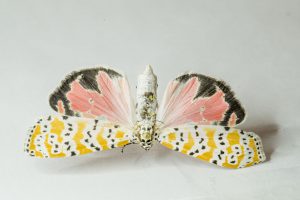Not all moths are night creatures. In fact, one of the most colorful moths in Florida, the bella moth Utetheisa ornatrix, is active during the day when we can admire its beauty.
The wings of the bella moth are a combination of orange, pink, white, and black, though the shades of the colors can vary. On their forewings, they have characteristic white bands on top of an orange background, with a row of black dots running through the center of the white bands. The hindwings, on the other hand, are pink with black margins.
The bella moth is not known for pollination, but rather for its role as a seed eater. As larvae, the bella moth first feeds on foliage of a particular group of plants, Crotalaria spp. or rattlepods, but then moves on to eating the seeds of the plant.

Though there are only two species of Crotalaria native to Florida, other species have been introduced. The plant provides protection to the moth – because the plant contains toxic pyrrolizidine alkaloids, larvae feeding on the foliage and seeds become poisonous and repellent to predators.
Due to these alkaloid compounds, rattlepods are also toxic to livestock that might forage on the plant. Bella moths play an important role in controlling these toxic plant populations by feeding on the plant seeds, thereby reducing plant reproduction and benefiting livestock and farmers.
While the bella moth is most known for its relationship with Crotalaria spp., and its role as a seed eater, adults have been found on numerous different flowers consuming nectar. There are many insects that, like the bella moth, are not known for their pollinating potential, but do visit flowers for protection, food, or mating purposes.
When insects visit a flower, regardless of the reason, they have the potential to act as pollinators. While not all pollinators are equally effective at pollinating, having a diversity of pollinators around may be best for a few reasons.
Different pollinators may be active at different times of the day and in different weather conditions, different pollinators have been shown to interact with one another in ways that increase flower visitation and pollination, and a diversity of pollinators offers insurance against population declines of individual species. As the bella moth is a one of a few day-flying moths, it can help to pollinate the many plants that flower during the day.
You can learn more about the bella moth here.
 0
0
